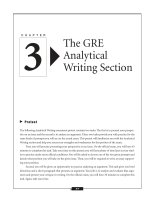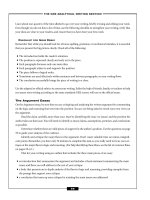The gre anlytycal writting section 2 pptx
Bạn đang xem bản rút gọn của tài liệu. Xem và tải ngay bản đầy đủ của tài liệu tại đây (131.47 KB, 6 trang )
The Quantitative section covers four types of math: arithmetic, algebra, geometry, and data analysis.
Arithmetic
The types of arithmetic concepts you should prepare for in the Quantitative section include the following:
■
arithmetic operations—addition, subtraction, multiplication, division, and powers of real numbers
■
operations with radical expressions
■
the real numbers line and its applications
■
estimation, percent, and absolute value
■
properties of integers (divisibility, factoring, prime numbers, and odd and even integers)
Algebra
The types of algebra concepts you should prepare for in the Quantitative section include the following:
■
rules of exponents
■
factoring and simplifying of algebraic expressions
■
concepts of relations and functions
■
equations and inequalities
■
solving linear and quadratic equations and inequalities
■
reading word problems and writing equations from assigned variables
■
applying basic algebra skills to solve problems
Geometry
The types of geometry concepts you should prepare for in the Quantitative section include the following:
■
properties associated with parallel lines, circles, triangles, rectangles, and other polygons
■
calculating area, volume, and perimeter
■
the Pythagorean theorem and angle measure
There will be no questions regarding geometric proofs.
Data Analysis
The type of data analysis concepts you should prepare for in the Quantitative section include the following:
■
general statistical operations such as mean, mode, median, range, standard deviation, and percentages
■
interpretation of data given in graphs and tables
■
simple probability
■
synthesizing information about and selecting appropriate data for answering questions
– THE GRE QUANTITATIVE SECTION–
145
The Two Types of Quantitative Section Questions
As stated earlier, the quantitative questions on the GRE will be either quantitative comparison or problem-
solving questions. Quantitative comparison questions measure your ability to compare the relative sizes of
two quantities or to determine if there is not enough information given to make a decision. Problem-solv-
ing questions measure your ability to solve a problem using general mathematical knowledge. This knowl-
edge is applied to reading and understanding the question, as well as to making the needed calculations.
Quantitative Comparison Questions
Each of the quantitative comparison questions contains two quantities, one in column A and one in column B.
Based on the information given, you are to decide between the following answer choices:
a. The quantity in column A is greater.
b. The quantity in column B is greater.
c. The two quantities are equal.
d. The relationship cannot be determined from the information given.
Problem-Solving Questions
These questions are essentially standard, multiple-choice questions. Every problem-solving question has one
correct answer and four incorrect ones. Although the answer choices in this book are labeled a, b, c, d, and
e, keep in mind that on the computer test, they will appear as blank ovals in front of each answer choice. Spe-
cific tips and strategies for each question type are given directly before the practice problems later in the book.
This will help keep them fresh in your mind during the test.
About the Pretest
The following pretest will help you determine the skills you have already mastered and what skills you need
to improve. After you check your answers, read through the skills sections and concentrate on the topics that
gave you trouble on the pretest. The skills section is followed by 80 practice problems that mirror those found
on the GRE. Make sure to look over the explanations, as well as the answers, when you check to see how you
did. When you complete the practice problems, you will have a better idea of how to focus on your studying
for the GRE.
– THE GRE QUANTITATIVE SECTION–
146
Pretest
Directions: In each of the questions 1–10, compare the two quantities given. Select the appropriate choice
for each one according to the following:
a. The quantity in Column A is greater.
b. The quantity in Column B is greater.
c. The two quantities are equal.
d. There is not enough information given to determine the relationship of the two quantities.
Column A Column B
1. z + w = 13
z + 3 = 8
zw
2. Ida spent $75 on a skateboard and an additional
$27 to buy new wheels for it. She then sold the
skateboard for $120.
the money Ida received in excess
of the total amount she spent $20
3.
xy
4. –2(–2)(–5) (0)(3)(9)
x°
z°
y°
l
1
l
2
l
1
ʈ l
2
– THE GRE QUANTITATIVE SECTION–
147
1. abcde
2. abcde
3. abcde
4. abcde
5. abcde
6. abcde
7. abcde
8. abcde
9. abcde
10. abcde
11. abcde
12. abcde
13. abcde
14. abcde
15. abcde
16. abcde
17. abcde
18. abcde
19. abcde
20. abcde
ANSWER SHEET
Column A Column B
5. 11 10 + x
6.
ᎏ
1
2
ᎏ
+
ᎏ
3
5
ᎏ
ᎏ
1
2
+
+
3
5
ᎏ
7.
the area of shaded
region PQS 36
8. R, S, and T are three consecutive odd
integers and R Ͻ S Ͻ T.
R + S + 1 S + T – 1
9.
the area of the shaded 9
rectangular region
10. x
2
y Ͼ 0
xy
2
Ͻ 0
xy
2
R
V
S
T
U
4
3
Q
R
S
P
V
T
The length of the sides in
squares PQRV and VRST is 6.
– THE GRE QUANTITATIVE SECTION–
148
Directions: For each question, select the best answer choice given.
11. ͙(42 – 6
ෆ
)(25 +
ෆ
11)
ෆ
a. 6
b. 18
c. 36
d. 120
e. 1,296
12. What is the remainder when 6
3
is divided by 8?
a. 5
b. 3
c. 2
d. 1
e. 0
13.
In the figure above, BP = CP.Ifx = 120˚, then y =
a. 30°.
b. 60°.
c. 75°.
d. 90°.
e. 120°.
14. If y = 3x and z = 2y, then in terms of x, x + y + z =
a. 10x.
b. 9x.
c. 8x.
d. 6x.
e. 5x.
A
BC
D
P
x°
y°
– THE GRE QUANTITATIVE SECTION–
149
15.
The rectangular rug shown in the figure above has a floral border 1 foot wide on all sides. What is the
area, in square feet, of the portion of the rug that excludes the border?
a. 28
b. 40
c. 45
d. 48
e. 54
16. If
ᎏ
d
7n
–
–
3n
d
ᎏ
= 1, which of the following must be true about the relationship between d and n?
a. n is 4 more than d
b. d is 4 more than n
c. n is
ᎏ
7
3
ᎏ
of d
d. d is 5 times n
e. d is 2 times n
17. How many positive whole numbers less than 81 are NOT equal to squares of whole numbers?
a. 9
b. 70
c. 71
d. 72
e. 73
9 ft.
6 ft.
– THE GRE QUANTITATIVE SECTION–
150









